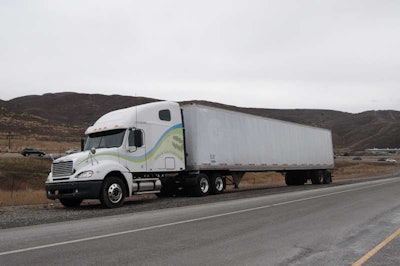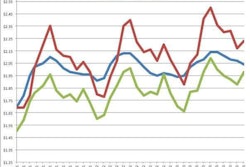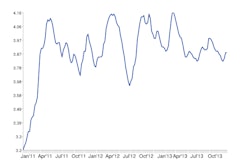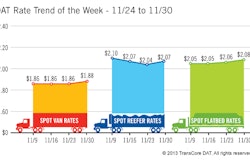 Glider kits, such as one for a Kenworth T660 similar to this 2013 model, can allow fleets to begin using natural gas trucks for less than purchasing a new dedicated LNG or CNG vehicle.
Glider kits, such as one for a Kenworth T660 similar to this 2013 model, can allow fleets to begin using natural gas trucks for less than purchasing a new dedicated LNG or CNG vehicle.During a recent visit to Salt Lake City, I learned that a partnership of companies is looking to make it easier for fleets to enter the natural gas market. The key player in the cooperative effort is American Power Group, a manufacturer of aftermarket natural gas fuel systems. The company designed its patented natural gas turbocharged dual-fuel conversion system to be simple and affordable for retrofit to diesel engines or installation on new 2014 model-year glider kits.
The result, says Steve Majkowski, APG’s vice president of sales and marketing, is a fuel-efficient productive truck that uses diesel fuel for compression but burns about 65 percent natural gas in daily vocational and hauling applications. Most appealing for fleets, Majkowski says, is the much lower acquisition cost of the glider kits, which he says allows fleets to begin using natural gas trucks for $30,000 to $70,000 less than purchasing a new dedicated LNG or CNG vehicle.
Other companies have joined APG to create a full-fledged natural gas package for interested fleets. They include Utah-based Smith Power Group, which assembles 2014 Freightliner Columbia tractors with APG natural gas fuel systems; and the WheelTime Group, which also offers natural gas glider kits and provides natural gas glider customers with fully-certified nationwide maintenance and repair support.
Glider confusion: The concept was born in the Pacific Northwest logging industry when trucks were hit by rolling logs
Title transfer: Regulations allow fleets or manufacturers to transfer an existing truck title to a glider kit
Immediate benefits: Fleets enjoy lower emissions, reduced acquisition and fuel costs and a higher resell value.
The Ervin Group also is assembling and selling glider trucks but primarily acts as the financing arm of this business venture, helping fleets with various financing and leasing packages to get them into the vehicles. Natural gas supplier Blu is the final piece of the puzzle; the Utah-based company is developing natural gas fueling stations and infrastructure throughout the West and working closely with interested fleets to get fuel to them – including a portable onsite fueling station that can be driven to a remote fleet location, be set up and begin fueling trucks in a few hours’ time.
Video log: Fueling, driving natural gas glider kit
Mark Meier of Smith Power Group says confusion over glider kits and how they can benefit fleets still pervades the trucking industry. The concept of a glider, Meier says, was born in the Pacific Northwest logging industry; trucks routinely were hit by rolling logs, which bashed in cabs and bodies but left drivetrains and chassis intact. Over time, government regulations allowed fleets to “recycle” these trucks by replacing cabs and bodies.
Today, gliders are more a title transfer than anything else; current regulations allow fleets or manufacturers to transfer an existing truck title to a glider kit. The main consideration is that the glider must be powered with a remanufactured engine and components equal to or better than the truck’s original equipment. If you’re a Detroit Series 60 fan, you can purchase a glider kit with a 1998 rebuilt engine that takes advantage of the latest emissions and fuel economy technologies – a perfect blend of proven components and new technology.
Majkowski says APG’s glider trucks are new 2014 model-year trucks that come with a standard one-year/100,000-mile warranty and offer immediate emissions and fuel economy benefits, including reduced acquisition and fuel costs and a higher resell value – with or without the company’s fuel system – thanks to natural gas being a cleaner-burning fuel. The result appears to be a highly productive yet affordable way for fleets to gain valuable experience with both LNG and CNG fuel while cutting emissions and saving significantly on fuel costs.











